Egg Battered Fries with a Spicy Lemon Dip (元江蛋酥洋芋)
In a lesser known corner of Yunnan, the local barbecue scene created a new twist on the French Fry.
What Papua New Guinea is to languages, the Yunnan province is to food. The sheer diversity of cuisines and dishes often… intimidates.
In our previous “63 Cuisines of China” guide, we had a (reasonable enough) breakdown of the cuisines in the province. After all, Yunnan food’s been an intellectual passion for a while, the Yunnanese in Huai Khwang was very much our scene in Bangkok, and of course we’d traveled here a number of times. And so in our guide, we listed six cuisines1: Han Yunnan, Hui Yunnan, Dali, Western Yunnan, Pu’er-Sipsongpanna, and Honghe.


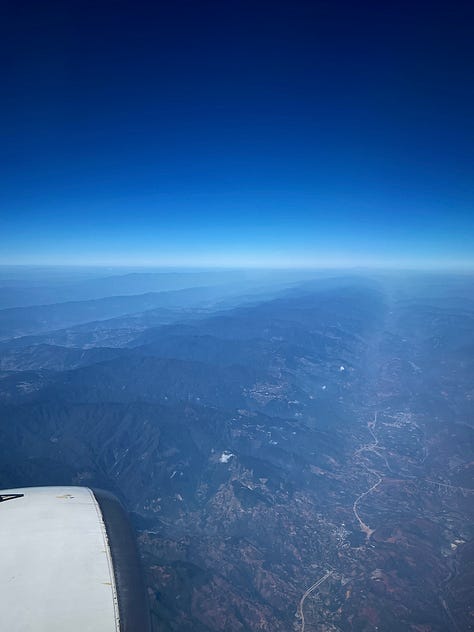
A fine enough start, I think, because the Hengduan range (above) does loom large here. It slices right through the province, historically splitting it all into distinct trading networks: the south around Pu’er-Sipsongpanna was very much one node on the caravan routes that extended deep into Northern Thailand. The west, meanwhile, was quite integrated with the Shan state across the border in neighboring Myanmar — a border that, until rather recently, was very much… an abstraction2.
But then there’s Honghe: that swath of the Red River, coming up from Vietnam. The China portion of this waterway is starkly unnavigable, the terminus of trade being a town near the Vietnam border called Manhao. Above that point, rapids3 block movement for most small vessels, and an imposing canyon makes movement across incredibly difficult. And so, the region was historically very much the home of highland groups — the Hani, the Yi, and the Hmong… making the food of the region a bit of a difficult-to-categorize hodgepodge.
If we continue moving up the river though, we arrive at the town of Yuanjiang. It’s not colored ‘Honghe’ on our map of cuisines above, though in hindsight maybe you could make the argument. Administratively, it lies underneath our current home of Yuxi, and is rather close to much of Han Yunnan as the bird flies.

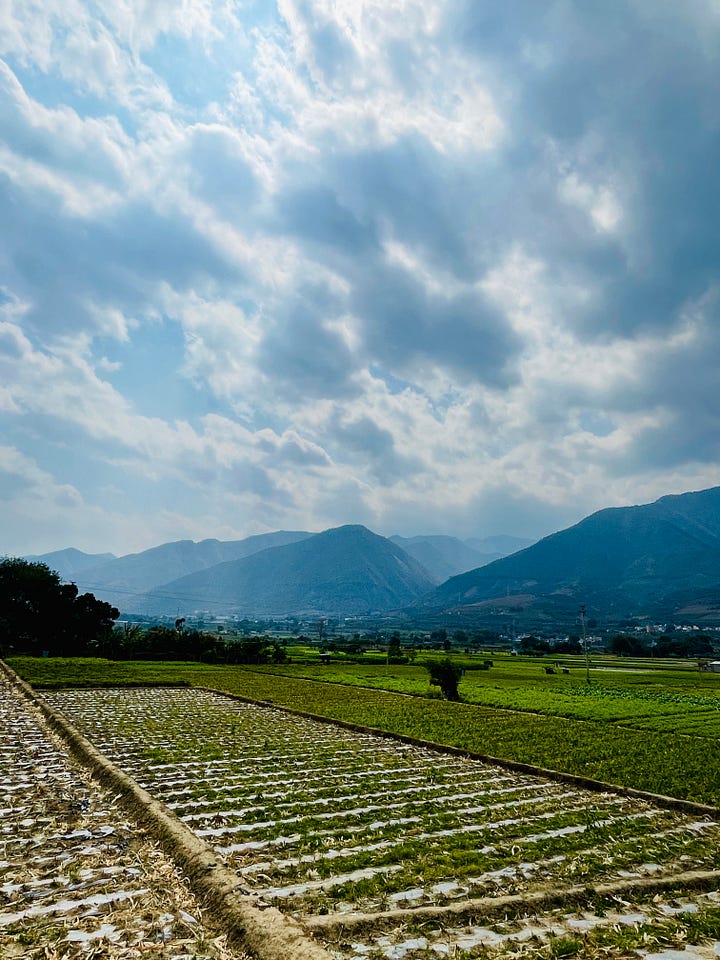
But unlike the rest of what’s administratively “Yuxi”, this place exists… smack dab inside of the canyon.
Demographically, it was historically quite Hani, but these day Han Chinese make up a plurality — especially in the urban areas. Climatically, it’s drastically different than either side of the valley — hot, muggy subtropical air sweeps right up the river… it’s not uncommon for Yuanjiang to be 10-15C hotter than either side of the ridge. And so, the town and its environs is a major center for mango production in Yunnan, together with citrus and all sorts of tropical fruits.
So to review, we’ve got (1) ethnic diversity (2) historical quasi-isolation, and (3) a unique micro-climate. What does that all do to a cuisine?
Food in Yuanjiang
Well, it makes it pretty fucking amazing. In a province packed with fantastic food, our handful of trips to Yuanjiang has thus far been a highlight.
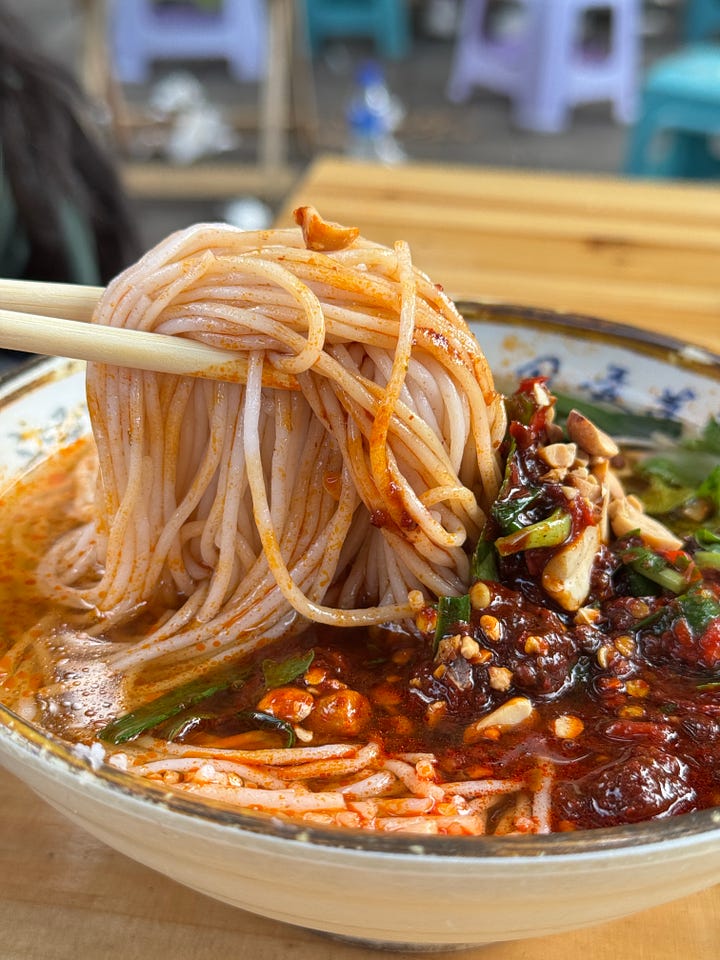
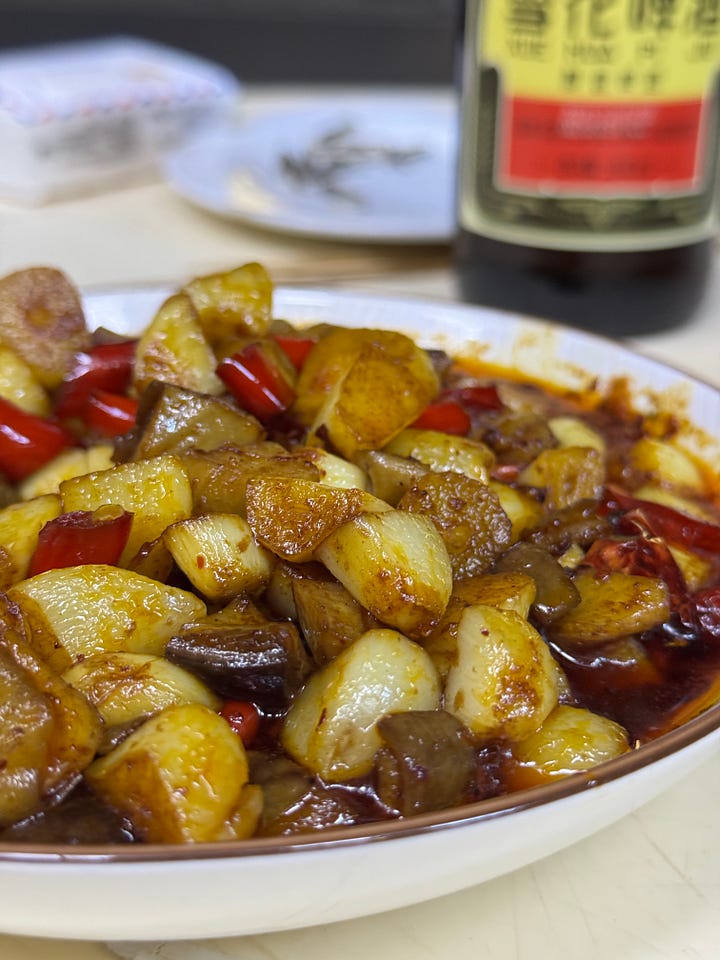
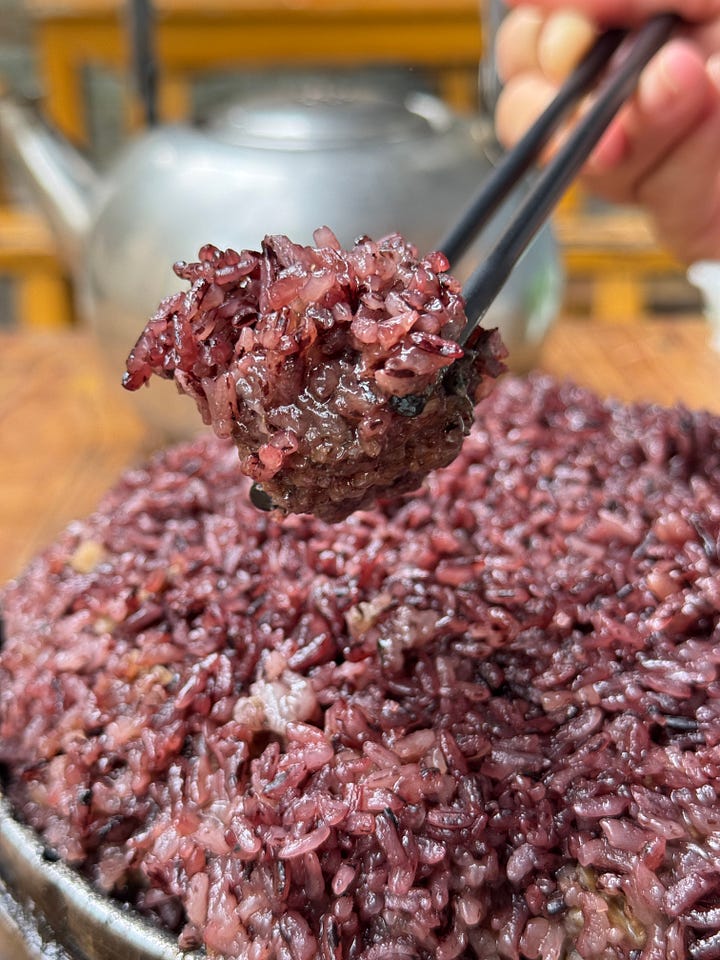
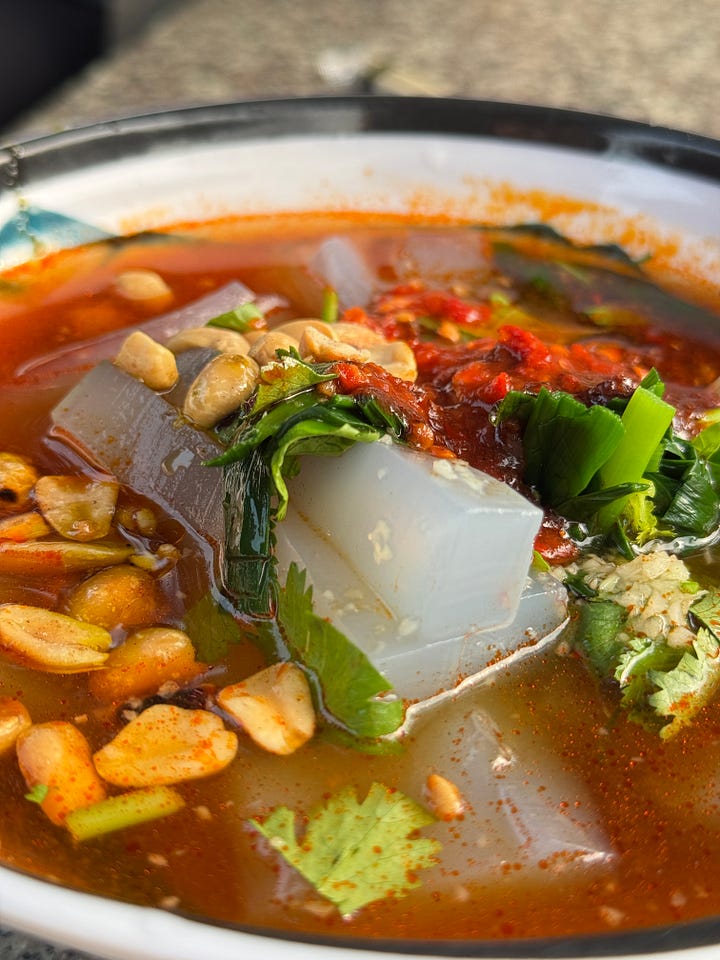
Now, I do think that we weren't completely wrong in our Cuisines of China post — basic mental model for food in Yuanjiang, I feel, should indeed be that of Han Yunnan. But there’s an interplay with tropical fruits that really make things special. In many swaths of Yunnan, you can find a ‘sour component of choice’ — vinegar in some parts, fermented rice liquid in others — in Yuanjiang, it’s tamarind, giving otherwise Han dishes an ineffable southeast Asian feel.
That’s also intermingled with Hani and Dai restaurants, of course:
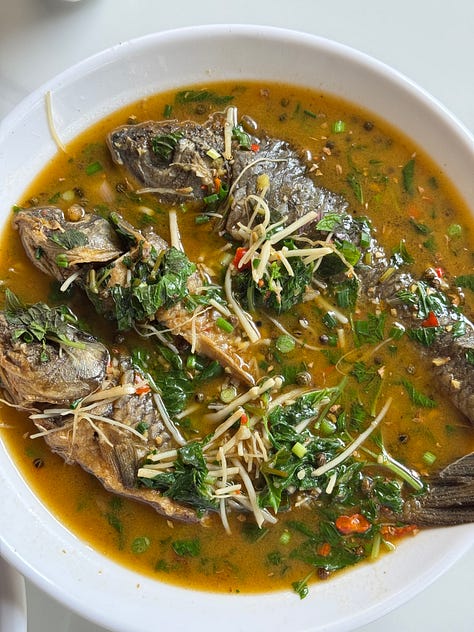

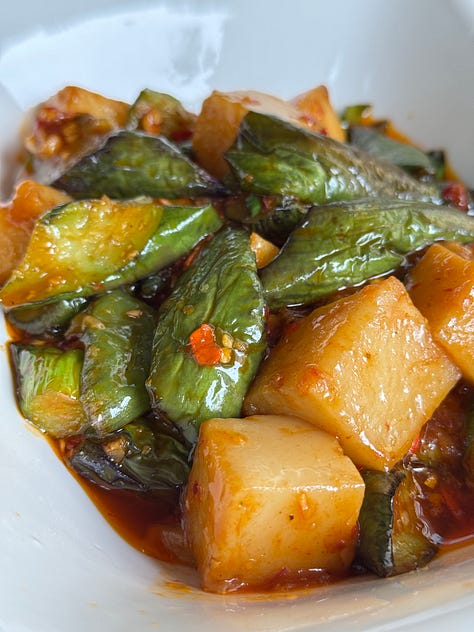
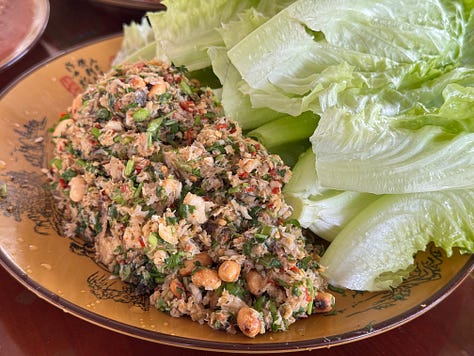
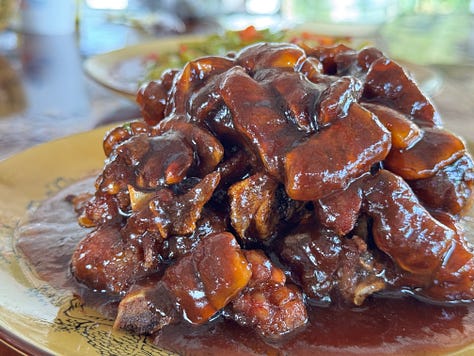
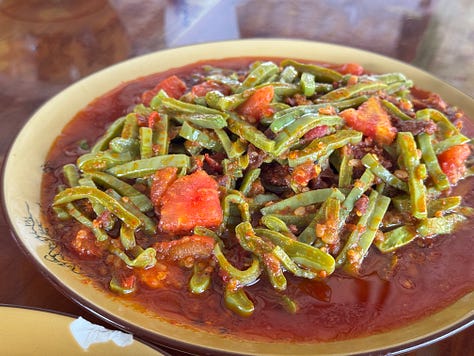
But it’s the town’s shaokao4 barbecue scene that’s really quite famous. Now at first glance (below, top right), it might not look overly different than a lot of Yunnan shaokao: satay makes an appearance for some reason, but besides that it’s a lot of ‘good versions’ of the usual suspects. It’s what comes with it that can be quite special, in my opinion:



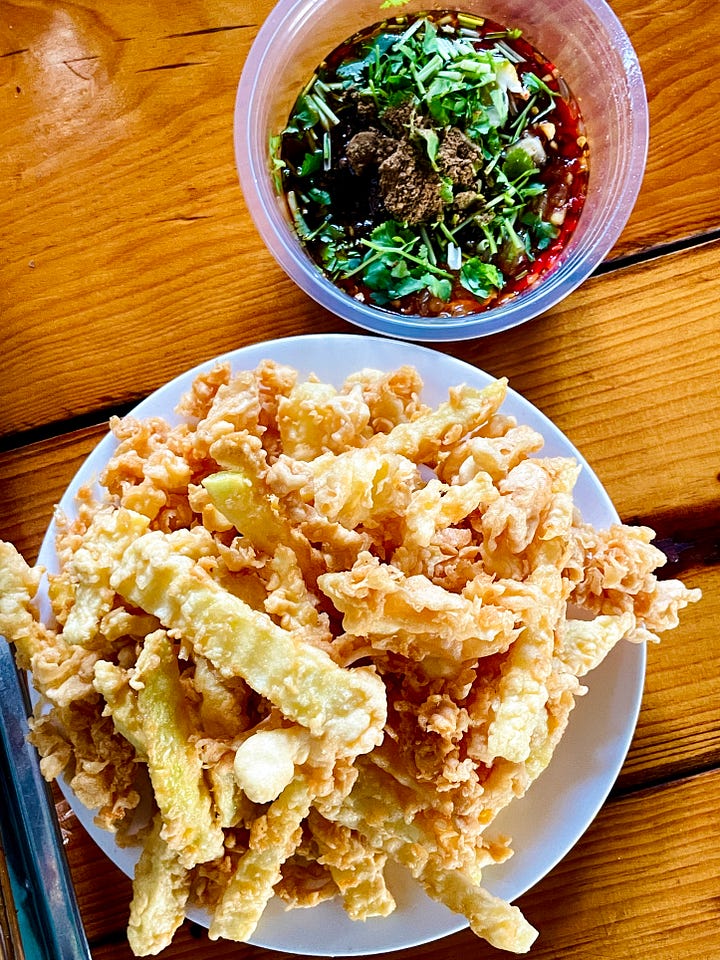
Above are two particular specialties: Beef Jerky Fried Egg Noodles (干巴鸡蛋面), and Egg Battered Fries (蛋酥洋芋). And while we want to cover all of the above Yuanjiang dishes in time (those tamarind cold noodles are ridiculous), we felt these shaokao fixtures might be the easiest to replicate outside of China. So perhaps we can start there — today, covering the Egg Battered Fries.
Egg Battered Fries (蛋酥洋芋)
So these obviously look quite a lot like the French Fries you might be used to, but they have a couple key differences.
First, unlike French Fries they’re not fried straight up until crisp. They are (as our translation suggests) battered, and battered rather aggressively. The end texture is something undeniably evocative of a French Fry, but a little different: they’re more su (酥) than ‘crunchy’. It’s one of those hard-to-translate Chinese ‘food texture’ words, and is roughly halfway between ‘crispy’ and ‘flaky’. Think, say, wafer thins — those are definitely quite su.
Second, they come with an absolutely fantastic dip that really cuts the richness of the deep-fry. It’s spicy, it’s lemon-y, and it really makes everything come together. So even if you’re not in the market for deep-frying, I would definitely suggest you try the dip nonetheless — it’s really excellent with practically anything with a thick coating (I think it might go great with American-style fried clams):
All of the above was an invention of a specific village outside of Yuanjiang called Ganzhuang (甘庄), though you can find it at barbecue joints pretty much everywhere in Yuanjiang these days. Tantalizingly, Ganzhuang is — for some reason? — the site of a small community of diaspora Chinese that re-settled in Yunnan from Southeast Asia (the origin of their satay skewers, it’s said?), but those threads proved a little difficult to unwind. Either way, said village sits about halfway up the ridge: the place functioned as a pitstop on the old G213 highway, and today is the site of Yuanjiang’s high speed rail train station.
Ganzhuang is actually rather popular among some Chinese travelers for this reason: if you get into Yuanjiang station rather late, they have a market specifically set up for Shaokao barbecue, where you can also definitely munch on these fries. Their weekend market is also rather renowned.
Recipe, Spicy Lemon-y Dip
Mince
3 cloves garlic
2 fresh spicy chilis, e.g. Thai Bird’s Eye or Chinese Millet Chili (小米辣)
Chop
1 sprig cilantro
In a bowl, mix the above with
2 slices lemon
2 tbsp soy sauce (生抽)
2 tbsp water
2 tbsp white rice vinegar5 (白米醋)
1 tsp oyster sauce
¼ tsp sugar
⅛ tsp salt
⅛ tsp MSG
Mix very well, really mushing the lemon into the rest of the sauce.
Recipe, Egg Battered Fries
Will function as a side dish split between 2-3 people.
Peel
One medium potato (our potato was roughly 315 grams after peeling)
and cut into ~¼ inch fries, preferably with a crinkle cut knife.
In a large basin, mix
120g self rising flour
2 eggs (~100g)
~3 tbsp of water
you will need less water if your eggs are heavier than ours — you are looking for a consistency roughly akin to pancake batter. Mix with chopsticks in a zig-zag pattern to avoid developing gluten, or fold with a silicone spatula.
Add the fries and fold it to coat. You will need to move quickly at this stage.
Get a wok of oil up to ~180C. Slide in the entirety of the mixing bowl. After about 5 seconds, jostle the potatoes well with chopsticks until broken apart. Repeat the same move after about 30 seconds, or when the batter has begun to form. Let it continue to fry at ~155C for four minutes over a high flame, or until the coating begins to slightly brown, and the oil temp begins to creep up back to 180C.
Remove and transfer to a paper towel lined baking tray. Sprinkle:
½ tsp salt6
toss, and then transfer to a serving plate.
Plus another two: Tibetan extending from the North into Deqin, and Zhuang-influenced Guangxi extending from the Southeast.
It should be emphasized, of course, that these areas also had considerable contact and trade with Han Yunnan (Kunming, etc). Not trying to give those goofballs on Twitter a reason to frantically update their moronic ‘China occupied’ maps – the point is more that this Chinese cultural influence is more of a gradient (especially historically) than a black-and-white line on a map may suggest.
I’m perhaps guilty of not knowing the precise definition of ‘rapids’, so someone please correct me if I’m wrong here. Still, the point stands that the river was not navigable — and hey, this dude characterized them as rapids, at least.
I should probably just go with the flow and translate “Shaokao” (烧烤) as “Chinese Barbecue”. But as both an American and a pedant, I can’t help but have a really quite restrictive definition of ‘barbecue’. To my mind, the technique of ‘barbecue’ refers to meat that’s cooked by smoking (and further, meant for immediate consumption, not preservation). It annoys me to no end when people refer to, say, Siu Mei (Cantonese Roast Meats) as “Chinese Barbecue”… as it can lead to odd situations such as American pit masters being disappointed at the lack of a smoke ring in a Char Siu. Smokiness is something to be avoided in Cantonese Siu Mei, at least traditionally.
Shaokao is certainly closer to Barbecue than Siu Mei, but really… the fundamental cooking method employed here is grilling, not smoking. So something like ‘grills’ might not be a terrible translation, but I think underplays the culture of the thing — Shaokao is an institution, an iconic street food, a late night favorite. So I bounce back and forth between ‘barbecue’, ‘grill stands’, and leaving it untranslated.
A Japanese rice vinegar would also work fine. If using a western style rice vinegar like Heinz (which has more acetic acid), cut the quality to 1.5 tbsp, and up the water to 2.5 tbsp.
Note that this was my own move for salting these things. They do not salt in this manner in Ganzhuang — I believe they add a little to the batter. I found that doing so ran me the risk of developing the gluten in the batter, which was why I opted for this undeniably rather western approach. It works, but do bear that in mind.




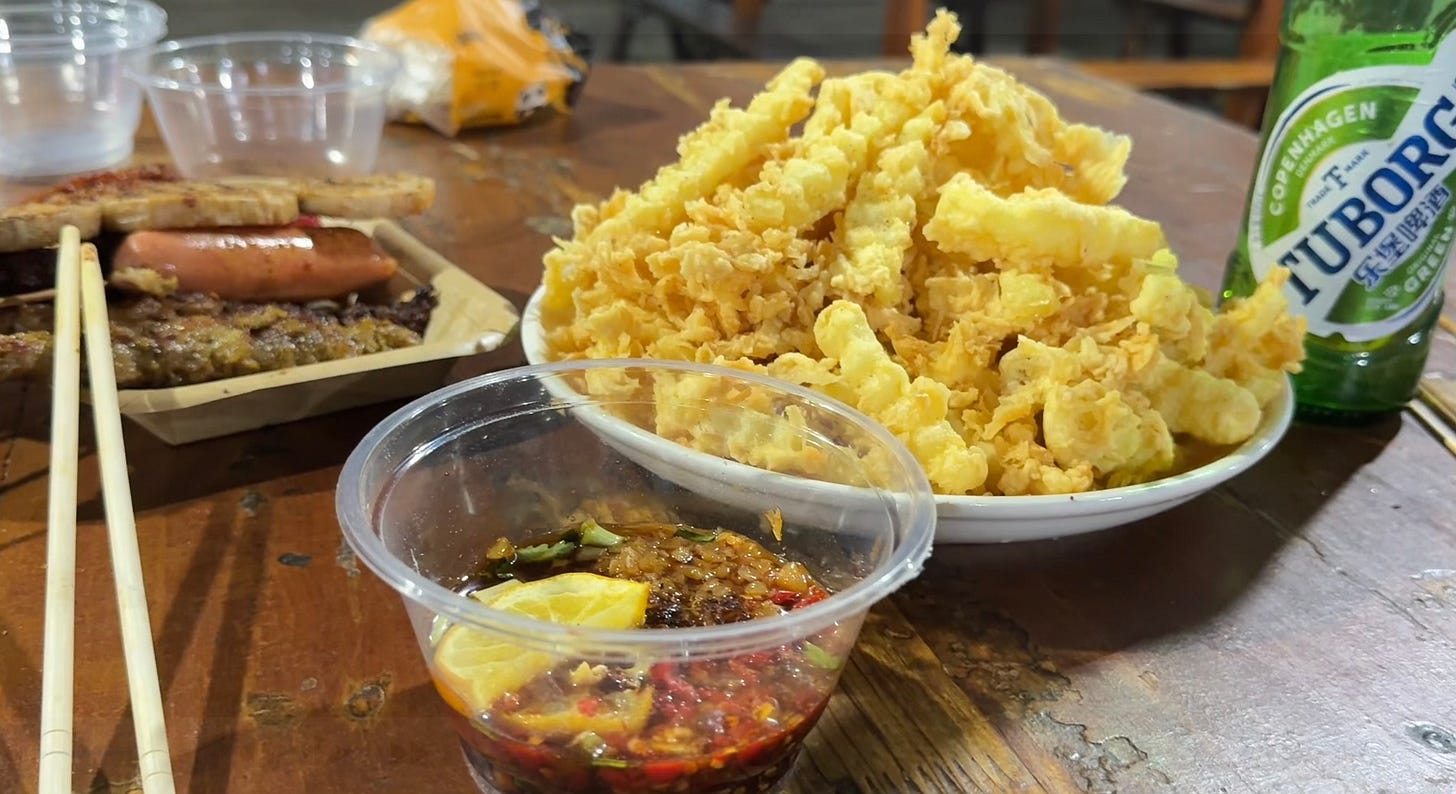

There is an "international scale of river difficulty", which is American origin, so not international...but I digress. Rapids are scaled from 1-5, with 1 as the gentlest and 5 as intense, with a 6th added a while back for those rapids that are just plain nuts, but if a kayaker successfully navigates a Class 6 several times, it might be downgraded to a 5x. Who knew?
The picture is probably about a 2 bordering up toward 3 maybe, for anyone curious.
Fries look yummy, btw.
What an incredible gastronomical voyage! Thank you for sharing such a transcending experience, and the recipe is fantastic too!!